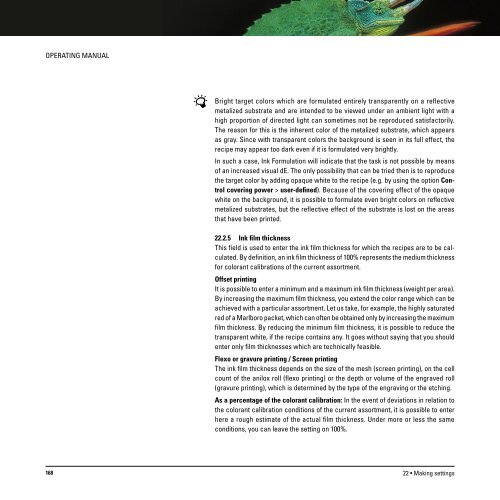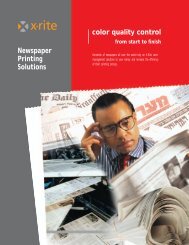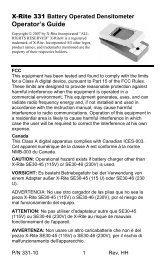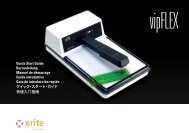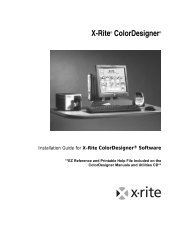Operating Manual
Operating Manual
Operating Manual
You also want an ePaper? Increase the reach of your titles
YUMPU automatically turns print PDFs into web optimized ePapers that Google loves.
OPERATING MANUAL<br />
Bright target colors which are formulated entirely transparently on a reflective<br />
metalized substrate and are intended to be viewed under an ambient light with a<br />
high proportion of directed light can sometimes not be reproduced satisfactorily.<br />
The reason for this is the inherent color of the metalized substrate, which appears<br />
as gray. Since with transparent colors the background is seen in its full effect, the<br />
recipe may appear too dark even if it is formulated very brightly.<br />
In such a case, Ink Formulation will indicate that the task is not possible by means<br />
of an increased visual dE. The only possibility that can be tried then is to reproduce<br />
the target color by adding opaque white to the recipe (e.g. by using the option Control<br />
covering power > user-defined). Because of the covering effect of the opaque<br />
white on the background, it is possible to formulate even bright colors on reflective<br />
metalized substrates, but the reflective effect of the substrate is lost on the areas<br />
that have been printed.<br />
22.2.5 Ink film thickness<br />
This field is used to enter the ink film thickness for which the recipes are to be calculated.<br />
By definition, an ink film thickness of 100% represents the medium thickness<br />
for colorant calibrations of the current assortment.<br />
Offset printing<br />
It is possible to enter a minimum and a maximum ink film thickness (weight per area).<br />
By increasing the maximum film thickness, you extend the color range which can be<br />
achieved with a particular assortment. Let us take, for example, the highly saturated<br />
red of a Marlboro packet, which can often be obtained only by increasing the maximum<br />
film thickness. By reducing the minimum film thickness, it is possible to reduce the<br />
transparent white, if the recipe contains any. It goes without saying that you should<br />
enter only film thicknesses which are technically feasible.<br />
Flexo or gravure printing / Screen printing<br />
The ink film thickness depends on the size of the mesh (screen printing), on the cell<br />
count of the anilox roll (flexo printing) or the depth or volume of the engraved roll<br />
(gravure printing), which is determined by the type of the engraving or the etching.<br />
As a percentage of the colorant calibration: In the event of deviations in relation to<br />
the colorant calibration conditions of the current assortment, it is possible to enter<br />
here a rough estimate of the actual film thickness. Under more or less the same<br />
conditions, you can leave the setting on 100%.<br />
168<br />
22 • Making settings


